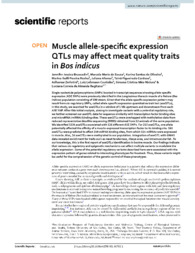Muscle allele-specific expression QTLs may affect meat quality traits in Bos indicus.
Muscle allele-specific expression QTLs may affect meat quality traits in Bos indicus.
Autoria: BRUSCADIN, J. J.; SOUZA, M. M. de; OLIVEIRA, K. S. de; ROCHA, M. I. P.; AFONSO, J.; CARDOSO, T. F.; ZERLOTINI NETO, A.; COUTINHO, L. L.; NICIURA, S. C. M.; REGITANO, L. C. de A.
Resumo: Abstract. Single nucleotide polymorphisms (SNPs) located in transcript sequences showing allele-specific expression (ASE SNPs) were previously identified in the Longissimus thoracis muscle of a Nelore (Bos indicus) population consisting of 190 steers. Given that the allele-specific expression pattern may result from cis-regulatory SNPs, called allele-specific expression quantitative trait loci (aseQTLs), in this study, we searched for aseQTLs in a window of 1 Mb upstream and downstream from each ASE SNP. After this initial analysis, aiming to investigate variants with a potential regulatory role, we further screened our aseQTL data for sequence similarity with transcription factor binding sites and microRNA (miRNA) binding sites. These aseQTLs were overlapped with methylation data from reduced representation bisulfite sequencing (RRBS) obtained from 12 animals of the same population. We identified 1134 aseQTLs associated with 126 different ASE SNPs. For 215 aseQTLs, one allele potentially affected the affinity of a muscle-expressed transcription factor to its binding site. 162 aseQTLs were predicted to affect 149 miRNA binding sites, from which 114 miRNAs were expressed in muscle. Also, 16 aseQTLs were methylated in our population. Integration of aseQTL with GWAS data revealed enrichment for traits such as meat tenderness, ribeye area, and intramuscular fat . To our knowledge, this is the first report of aseQTLs identification in bovine muscle. Our findings indicate that various cis-regulatory and epigenetic mechanisms can affect multiple variants to modulate the allelic expression. Some of the potential regulatory variants described here were associated with the expression pattern of genes related to interesting phenotypes for livestock. Thus, these variants might be useful for the comprehension of the genetic control of these phenotypes.
Ano de publicação: 2021
Tipo de publicação: Artigo de periódico
Unidade: Embrapa Pecuária Sudeste
Observações
1 - Por padrão são exibidas publicações dos últimos 20 anos. Para encontrar publicações mais antigas, configure o filtro ano de publicação, colocando o ano a partir do qual você deseja encontrar publicações. O filtro está na coluna da esquerda na busca acima.
2 - Para ler algumas publicações da Embrapa (apenas as que estão em formato ePub), é necessário ter, no celular ou computador, um desses softwares gratuitos. Sistemas Android: Google Play Livros; IOS: iBooks; Windows e Linux: software Calibre.
Acesse outras publicações
Acesse a Base de Dados da Pesquisa Agropecuária (BDPA) para consultar o acervo completo das bibliotecas da Embrapa.

